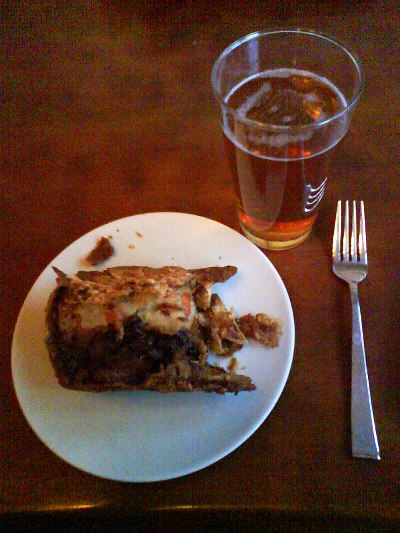I've just finished my last piece of a Kit-Cat Pie, a culinary delicacy from the 1600s, which I heard about while reading the third book in Neal Stephenson's Baroque Cycle trilogy. <!-- SUMMARY_END -->

The Baroque Cycle is set in the 1600s, at the dawn of modern science, finance, and politics. The story follows Daniel Waterhouse, the son of an English Dissenter, as he becomes a Natural Philosopher and fellow of the Royal Society and navigates the politics of the day, particularly the mathematical and philosophical conflict between Isaac Newton and Gottfried Liebniz. One of the themes of the book is how many things that we consider quite separate now were at that time still mixed. For example, what we consider science was just emerging from, and still intermingled with, the more ancient alchemy. People were still figuring these things out. (An implicit message of the book is that there are things we're working out today that will one day be considered distinct. It's looking like my jack-of-all-trades web technologist job is one such thing).
Some of my favorite parts of the book are scenes in the Kit-Cat Clubb, a gathering place for the progressive Whig politicians and their familiars like Daniel. Goings-on at the Kit-Cat revolve around drinking, spontaneous recitations of verse, and meat pies. One passage in particular is a paeon to these pies, in much the same vein as the insanely detailed description of Randy Waterhouse's breakfast of Cap'n Crunch in Cryptonomicon.
The other day I googled around for information on the Clubb and came across Ophelia Fields' book The Kit-Cat Club: Friends who imagined a nation. It turns out that not only was the Clubb a real entity that played an important part in British history, but the pies were more integral to the Clubb than I thought, her web site includes a downloadable PDF with recipes for these pies from circa 1700. It was clear that I'd have to make one myself. After much toil I completed recipe #4, a pie containing mutton, onions, apples, raisins, and various spices, wrapped in an insanely butterific pie crust and topped with a gravy made from more butter, mutton, bacon, onions, carrots, and a lemon.
Like Stephenson, Fields points out that things back in the 1700s were a little blurry -- English cuisine hadn't adopted the French-style distinction between savory and sweet, and I can confirm that. The pie had a strange tangy flavor that definitely took some getting used to. I don't know if I just got used to or it or whether the flavor changes when it keeps in the fridge, but it really started to grow on me as we've eaten it over the last couple days. Una and I both came to really enjoy the complex flavor it had. If it wasn't for the super-unhealthy crust and the long preparation we would totally make this all the time. As it is we'll probably put it on the special-occasions list.